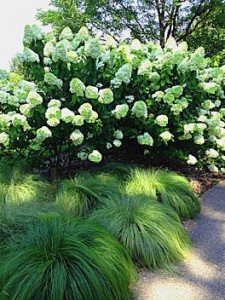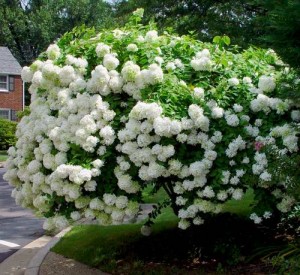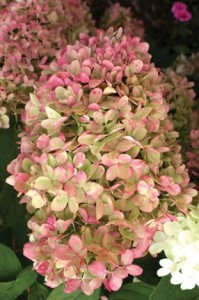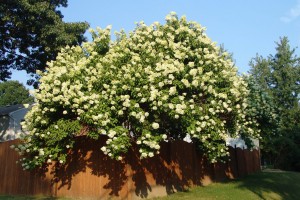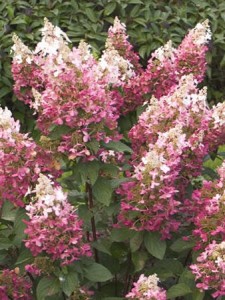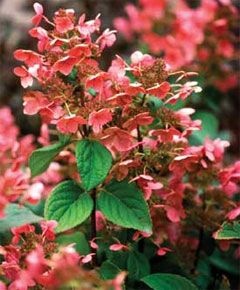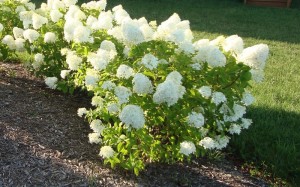Hydrangea paniculata is one of the easiest ways to get a large, long lasting, dramatic show of flowers in your garden.These Hydrangeas are very different from their Bigleaf Hydrangea cousins.These are large, fast growing woody shrubs that produce large white blooms that last all summer.They have none of the problems that Bigleaf Hydrangeas have.They are very hardy and bloom on first year branches. Most varieties are hardy to Zone 3!They also love sun and do not wilt every time the hot sun shines on them.The best thing about these Hydrangeas is that the flower very reliably and profusely.It is rare to see a PeeGee Hydrangea that doesn’t bloom well.
The Basics of PeeGee Hydrangeas (Hydrangea paniculata)
One of the first widely planted varieties of Hydrangea paniculata was Hydrangea paniculata ‘Grandiflora’.
This quickly became known as Hydrangea “P. G.”Since then, numerous other cultivars have been introduced, but the nickname has carried through to the entire group.These days, most nurseries will reluctantly refer to all cultivars of Hydrangea paniculata as “PeeGee’s”.
One of the few drawbacks to PeeGee Hydrangeas is the lack of color choice.Flowers are almost universally white.The flower heads do have some other interesting characteristics.The flowers of most cultivars turn from white to a rose pink color toward the end of the season.This is where a lot of the cultivars differ.Some offer earlier transition to pink, others promise more pink than others.
Care and Maintenance of PeeGee Hydrangeas (Hydrangea paniculata)
Unlike other Hydrangeas, PeeGee Hydrangeas love sun.They can take hot sun and even take partial shade.
They will not bloom well in full shade, but they will live and bloom sporadically.Picking the perfect spot is not necessary for PeeGee’s. They are versatile and reliable in many situations.
Care of PeeGee Hydrangeas in minimal and only consists of proper pruning and trimming.Most PeeGee varieties grow fast and should be trimmed back hard every year to keep them in check.Some newer varieties are compact and do not need extensive trimming.For most PeeGee’s, one good haircut each early spring works well.Most varieties will get lanky and sprawling if not trimmed yearly.A nice thing about PeeGee’s is that you don’t need to follow any rules on trimming them.They respond well to even the roughest haircut.So, trim them each spring to the size you want and expect a few feet of new growth each season for most varieties.
The Best Varieties of PeeGee Hydrangeas (Hydrangea paniculata)
As we discussed earlier, PeeGee Hydrangea flowers are generally white with some transition to pink as the season progresses.Most of the cultivars are offering improvements on this color transition, while some may be focusing on plant size.One of the few complaints about PeegGees is their large size and informal habit they develop if not trimmed regularly.New cultivars are available that claim to be more compact.Time will tell if this holds to be true in the garden.
Here is our rundown of the popular varieties and which we think are the best.
Grandiflora (Hydrangea paniculata ‘ Grandiflora’) – This is the classic forefather
of the PeeGees.It is a reliable bloomer, but compared to some of the newer cultivars, the flowers are not as showy.The flower heads are white balls about baseball to softball size that fade to pink in the fall.It can reach a height of over 10 feet after many years and take on the habit of a small tree. In fact, you may find it in the nursery pruned into tree form.This is a great garden plant, but it has been outdone by newer introductions.
Limelight (Hydrangea paniculata ‘Limelight’) – This one of our favorites!And it’s very easy to find.Limelight gives you the most stunning flowers of all the PeeGees.
These large flower heads begin to bloom with a faint green hue, thus giving this cultivar its name.The flowers then mature to pure white and in the fall, develop a pink hue.Frequent watering and lots of sun will get you the biggest, showiest flowers.The only downside to ‘Limelight’ is its size.It can get big and lanky if not trimmed yearly.So, give ‘Limelight’ a sunny spot and some room, and give it a hard trim each spring before the leaves emerge. A well established plant can easily put on 3-4 feet of new growth (with flowers!) after trimming.
Tardiva (Hydrangea paniculata ‘Tardiva’).Tardiva is a lovely Hydrangea that has a similar growth habit to ‘Limelight’ that requires hard pruning each spring, but its flowers form a long open cone that is quite different than ‘Limelight’ or ‘Grandiflora’.This type of flower is the most common in the PeeGees. It gives the plant a less formal look, but the flowers are very interesting, especially at close range. As with all PeeGees, the white flower heads turn pink in late season.Other cultivars like ‘Kyushu’ and ‘Unique’ are almost identical to ‘Tardiva’.Unfortunately, while these are lovely plants, like ‘Grandiflora’, they have been outdone by newer varieties.Read on to see what improved varieties have to offer.
Pinky Winky (Hydrangea paniculata ‘Pinky Winky’) – Also readily available, Pinky Winky is a significant improvement on the similar ‘Tardiva’, ‘Unique’ and ‘Kyushu’.The plant is more upright, so flower heads tend to point upward and have a deep pink hue in late season.Overall, the entire plant keeps an elegant look all season.It does not grow quite as fast as ‘Limelight’ but still give it a good trim each spring. ‘Pinky Winky’ is a real crowd pleaser.
Quick Fire (Hydrangea paniculata ‘Quick Fire’) – Also readily available.Quick Fire is very similar to ‘Pinky Winky’ but claims to bloom up to one month before othe PeeGee varieties.This may be a bit of an exaggeration, but it does bloom earlier.
Our experience shows that the flower heads of ‘Pinky Winky’ tend to be larger and a little more showy, but overall the plants are very similar.If bloom time is more important to you, then go with ‘Quick Fire’, otherwise, ‘Pinky Winky’ won’t disappoint.
Some new introductions to mention are “Little Lime’ and “Little Quick Fire’.Both promise to be more compact varieties of their big brothers.Since these varieties are so new, we can’t say from experience if the claims are true, but it might be worth giving them a try.In case it didn’t show in our descriptions above,‘Limelight’ and ‘Pinky Winky’ are our favorites of the Hydrangea paniculata group.One other noteworthy mention is ‘Little Lamb’.This plant looks absolutely dismal in a pot at the nursery, which is why most nurseries won’t sell it.If you are lucky enough to find it, take a chance on it!
This Hydrangea will form a large rounded shrub about 5ft tall and wide and it will be covered with very dense snowballs of white fading to pink.It will take 3 or 4 years to mature, but it’s worth the wait.What makes this Hydrangea so special is its flower heads made up of tiny florets.While the flower heads are large, they have smaller features than ‘Limelight’ or ‘Grandiflora’ giving this plant a special refined look.
Overall, the PeeGee Hydrangeas are a reliable and easy to grow group of Hydrangeas.Even though we have our favorites, there is hardly a dud among all of the varieties on the market.So, go out and get one and start appreciating the flower show this year!


